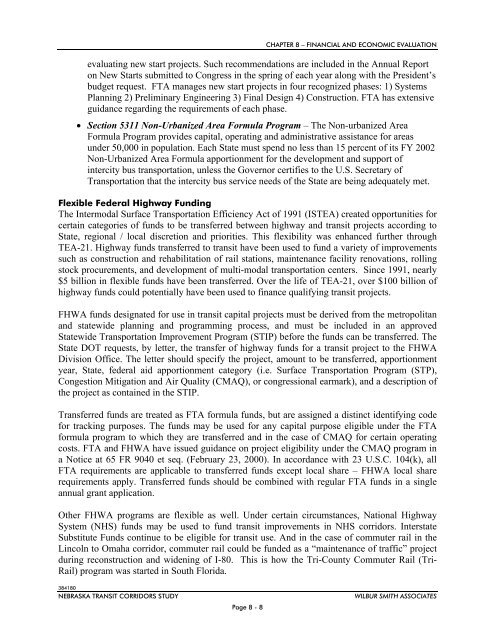NTRAC Final Study - Nebraska Department of Roads - State of ...
NTRAC Final Study - Nebraska Department of Roads - State of ...
NTRAC Final Study - Nebraska Department of Roads - State of ...
You also want an ePaper? Increase the reach of your titles
YUMPU automatically turns print PDFs into web optimized ePapers that Google loves.
CHAPTER 8 – FINANCIAL AND ECONOMIC EVALUATION<br />
evaluating new start projects. Such recommendations are included in the Annual Report<br />
on New Starts submitted to Congress in the spring <strong>of</strong> each year along with the President’s<br />
budget request. FTA manages new start projects in four recognized phases: 1) Systems<br />
Planning 2) Preliminary Engineering 3) <strong>Final</strong> Design 4) Construction. FTA has extensive<br />
guidance regarding the requirements <strong>of</strong> each phase.<br />
Section 5311 Non-Urbanized Area Formula Program – The Non-urbanized Area<br />
Formula Program provides capital, operating and administrative assistance for areas<br />
under 50,000 in population. Each <strong>State</strong> must spend no less than 15 percent <strong>of</strong> its FY 2002<br />
Non-Urbanized Area Formula apportionment for the development and support <strong>of</strong><br />
intercity bus transportation, unless the Governor certifies to the U.S. Secretary <strong>of</strong><br />
Transportation that the intercity bus service needs <strong>of</strong> the <strong>State</strong> are being adequately met.<br />
Flexible Federal Highway Funding<br />
The Intermodal Surface Transportation Efficiency Act <strong>of</strong> 1991 (ISTEA) created opportunities for<br />
certain categories <strong>of</strong> funds to be transferred between highway and transit projects according to<br />
<strong>State</strong>, regional / local discretion and priorities. This flexibility was enhanced further through<br />
TEA-21. Highway funds transferred to transit have been used to fund a variety <strong>of</strong> improvements<br />
such as construction and rehabilitation <strong>of</strong> rail stations, maintenance facility renovations, rolling<br />
stock procurements, and development <strong>of</strong> multi-modal transportation centers. Since 1991, nearly<br />
$5 billion in flexible funds have been transferred. Over the life <strong>of</strong> TEA-21, over $100 billion <strong>of</strong><br />
highway funds could potentially have been used to finance qualifying transit projects.<br />
FHWA funds designated for use in transit capital projects must be derived from the metropolitan<br />
and statewide planning and programming process, and must be included in an approved<br />
<strong>State</strong>wide Transportation Improvement Program (STIP) before the funds can be transferred. The<br />
<strong>State</strong> DOT requests, by letter, the transfer <strong>of</strong> highway funds for a transit project to the FHWA<br />
Division Office. The letter should specify the project, amount to be transferred, apportionment<br />
year, <strong>State</strong>, federal aid apportionment category (i.e. Surface Transportation Program (STP),<br />
Congestion Mitigation and Air Quality (CMAQ), or congressional earmark), and a description <strong>of</strong><br />
the project as contained in the STIP.<br />
Transferred funds are treated as FTA formula funds, but are assigned a distinct identifying code<br />
for tracking purposes. The funds may be used for any capital purpose eligible under the FTA<br />
formula program to which they are transferred and in the case <strong>of</strong> CMAQ for certain operating<br />
costs. FTA and FHWA have issued guidance on project eligibility under the CMAQ program in<br />
a Notice at 65 FR 9040 et seq. (February 23, 2000). In accordance with 23 U.S.C. 104(k), all<br />
FTA requirements are applicable to transferred funds except local share – FHWA local share<br />
requirements apply. Transferred funds should be combined with regular FTA funds in a single<br />
annual grant application.<br />
Other FHWA programs are flexible as well. Under certain circumstances, National Highway<br />
System (NHS) funds may be used to fund transit improvements in NHS corridors. Interstate<br />
Substitute Funds continue to be eligible for transit use. And in the case <strong>of</strong> commuter rail in the<br />
Lincoln to Omaha corridor, commuter rail could be funded as a “maintenance <strong>of</strong> traffic” project<br />
during reconstruction and widening <strong>of</strong> I-80. This is how the Tri-County Commuter Rail (Tri-<br />
Rail) program was started in South Florida.<br />
384180<br />
NEBRASKA TRANSIT CORRIDORS STUDY<br />
Page 8 - 8<br />
WILBUR SMITH ASSOCIATES

















